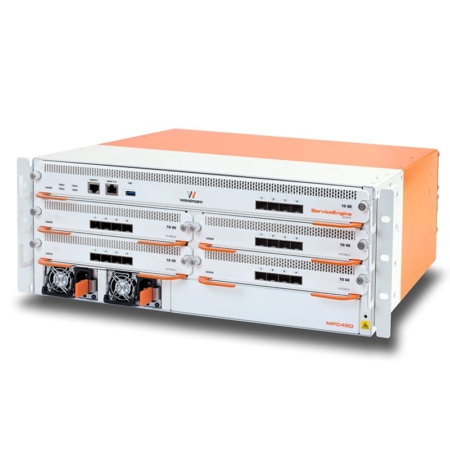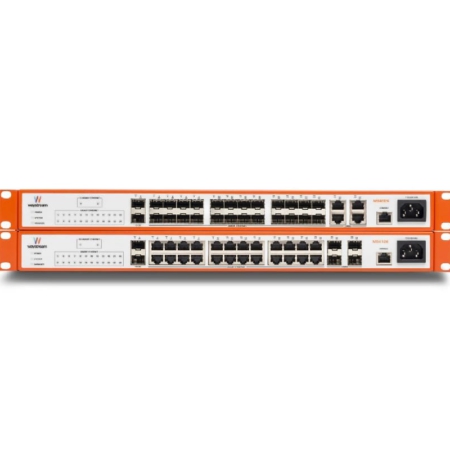Description
The LS2300 can be used in fiber to the home broadband networks as an aggregation switch, or in datacenter and enterprise environments where high-speed switching of servers and infrastructure is required.
The LS2300 architecture supports line-speed operation on all ports and has an extensive feature set that includes advanced QoS, redundancy protocols, and even Layer 3 routing.
Furthermore, the LS2300 has a compact form-factor – only 36 cms deep – with pluggable power modules and replaceable fans for front-to-back airflow. In addition, an envolving MPLS feature set enables the LS2300 to function as an edge router in new and exciting services that offer simplified management.
- Lower CAPEX
Up to 50% cost savings compared to other brands - Small-form factor, high performance
480Gbps switching / 360Mpps throughput, 1RU, 36 cm depth, 24x10Gbit/s SFP+, 1+1 AC/DC power, front-to-back cooling - Extensive feature-set
L2 and L3 redundancy options, Security to protect the network, Comprehensive multicast features
Site aggregation in FTTx and broadband deployment
Deployment of fiber to the home and other broadband technologies often means numerous points-of-presence locations with access nodes spread over a wide geographical area. The LS2300 provides a cost efficient aggregation layer to many different types of access nodes.
The high density 10Gbit/s port of the LS2300 allows a single unit to cover a large number of access nodes, and enables redundant uplink connections. With redundancy protocols, the LS2300 can connect to the network core in ring topologies as well as star-topologies.
The high performance switching also allows the LS2300 to serve as the core switch in networks with many thousands of subscriber connections.
Layer 2 aggregation
In a typical Layer 2 aggregation topology, the LS2300 switches are deployed in a ring architecture to provide redundant paths for connected access nodes in case of link-failures in the aggregation layer. Figure 1 shows a dual ring, that uses link-aggregation and redundancy-protocols between the LS2300 to achieve high reliability.
The access-nodes can also be connected in redundant topologies if they are further distributed throughout the local geographical area. Another common architecture, as shown in figure 1, is to have point-to-point connections from the LS2300 to the access nodes in a standard star topology. This solution reduces costs and complexity when the access nodes and L2300 switch are located in the same physical location.
Cost efficient 10Gbit/s copper or short range fiber links within the installation rack can connect the access nodes to the LS2300. The LS2300 supports the full VLAN-range, i.e. one VLAN per customer port in the access node. Using double-tagging in the LS2300, the connected access nodes can support thousands of access ports for connecting subscribers.
Layer 3 distribution
In some networks, access nodes provide routed uplinks. Ring topologies using routing protocols such as OSFP provide fast convergence and enable redundant paths with load sharing to be deployed. Daisy chains of multiple access nodes as shown in figure 2 makes efficient use of the Layer 3 routing solution and simplify troubleshooting, network aggregation and network.
The LS2300 supports standard routing protocols with up to 8,000 IPv4 routes in internal tables. In many networks, this is more than enough to support thousands of subscribers because access nodes combine many subscribers into a few IPv4 prefixes. With IPv6 support also included in the LS2300 platform, access nodes can connect dual stack clients.
Extensive feature set
The LS2300 has an extensive Layer 2 and Layer 3 feature set that supports a variety of needs across operator- and enterprise networks. A comprehensive list of L2/L3 redundancy protocols allow the LS2300 to be used in mission-critical, high-availability deployments.
Fast convergence on Layer 2 networks using ERPS or standard spanning-tree with support for OSPF and BGP, allows the LS2300 to fit into demanding network environments. Security features such as DHCP snooping, ARP inspection, and IP source guard prevent spoofing and denial-of-service attacks from end users. A broad selection of multicast related functions makes the LS2300 ideal in networks deploying TV services on multicast.
The LS2300 can operate an onboard DHCP server, or work together with a network DHCP server for IPv4 and IPv6, thereby adding vital DHCP options for maximum user traceability.
Flexibe power options
Redundant hot-swappable power supplies support either 220V AC or -48VDC power feeds. This allows the LS2300 to be deployed in any facility and to work with UPS solutions for Telco systems using AC and DC.
In addition, the system is cooled by three hot-swappable that enable front-to-back cooling thereby meeting the requirements of modern data centers and installations.
High capacity and high performance
The LS2300 is built around high performance circuits, that support line-rate speed on all ports. The total throughput of the system is 480Gbit/s. The system can handle up to 360 million packets per second.










